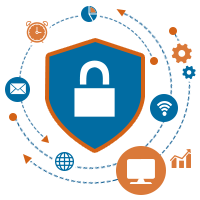Cloud computing is rapidly emerging technology in today’s scenario. The cloud working environment is some kind of open distributed system, which is used to preserve data with users privacy. Appending cloud computing with access control policies ensure the authorized access to data and systems. This blog will be discussing different features that will be connected with access control mechanism, applicable to cloud computing. You should know a comparison between cloud computing Vs Traditional IT infrastructure.
Introduction to Access Control
Access Control is a policy or process for enabling, denying, and restricting the real-time access. It monitors and records the attempts that are made while accessing the machine. Access control mechanism is capable of detecting unauthorized access to the machine and hence, stopping it suddenly. This type of security mechanism is very much important for data protection either on computers or on the cloud.
There are n numbers of large distributed open machines, which are growing rapidly in today’s market. These are considered as cloud computing and grid computing technologies where the things are like virtual organizations with several autonomous domains. In cloud storage environment, the relationship between end users and resources is dynamic as well as ad-hoc. There is no similarity between the users and cloud resource providers. Autonomous domains are having a different set of cloud data security policies. These policies are set to make the access control mechanism flexible to support all types of domains.
Types of Access Control
In general, there are following modules available for access control technology:
- Attribute-based Access Control: This type of access control system is designed or programmed with set of policies and rules of the organization. It helps in granting permissions to users whosoever is authentic to access the files.
- Discretionary Access Control: The enterprise owner decides that whom he/she wants to give data access. This will allow employees to access only those resources, which are assigned to them by owner.
- History-Based Access Control: Depending upon the real-time evaluation, the owner learns the activity of users in real-time and then, assign the permissions accordingly. The activity can be any like human behavior, request time, working performance, etc.
- Identity-Based Access Control: This type of access control in cloud computing environment manages activity as well as access to the individual requirements. This is dependent upon the user identity in cloud computing, which is made in front of the technician or owner.
- Mandatory Access Control: Users are not having freedom to identify that who all are having rights to access which file. For example, security clearance of users and data classification both these things are used as security labels for defining the trust level factor.
- Organization-Based Access Control: Independent from the implementation, OrBAC model permits system programmers to describe their own set of access control in the cloud environment.
- Role-Based Access Control: This access control policy is determined by the machine, not by the director of the firm. It is generally used for controlling access to the resources. Basically, RBAC controls the collection of permissions that involves complicated operations too. Learn about data loss prevention and how it is beneficial for you.
- Responsibility-Based Access Control: In this type, the access control mechanism is implemented on the basis of existing responsibilities at business level. Depending upon the responsibilities, things are allotted to the employees or users.
Core Elements of Access Control in Cloud Computing
The following 3 factors are kept in mind while implementing access control in cloud computing environment:
- Identification: The major purpose of access control mechanism is protection of confidential files from unauthorized accessing. It also helps in controlling the user’s activities all on one panel.
- Authentication: Once the identification procedure finishes, next comes the authentication. This factor ensures that right person will be assigned to their range of assigned permissions only.
- Authorization: Access control in cloud computing environment will be able to permit users with accessing of confidential data but, that will be based upon certain criterion. These are decided either by business owner or organization admin.
Conclusion
In cloud computing, access control system is performed by the account login credentials. This includes passwords, biometric access, and personal identification number. Therefore, always create security parameters strong so that no hackers or attacker can break the security to cause cyberattacks. Additionally, you can fetch more information about Cloud Computing Solutions.









